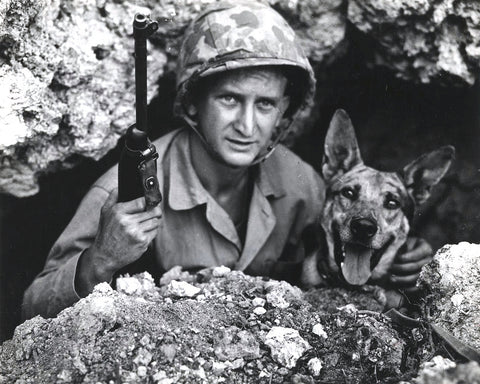Military Working Dogs

Humans aren’t the only ones who can be brave war heroes. Dogs can too! Military working dogs undergo strict training and are sent overseas to join in the war effort.
Since their domestication, dogs have long been trained and used in combat. Their bravery, selflessness, devotion, strong instincts, keen sense of smell, and amazing hearing make them a powerful ally.
History
Dogs have been deployed in war for thousands of years by civilizations spanning the globe. From the Greeks to the Persians, the Romans to the Britons, dogs were used as scouts, trackers, guards, patrollers, and fighters.
Large dogs like mastiffs and molossers were commonly strapped with armor and used on the front lines of battle.
During World War I, Europeans utilized dogs for pulling carts filled with weapons, supplies, or wounded soldiers. Dogs were occasionally used to deliver important messages, and they were oftentimes used as guards due to their ability to detect incoming bombs or attackers.
Their incredible sense of smell led to being utilized worldwide for detecting landmines, but the electric shock from discovering those mines took a toll on the dogs and the practice has decreased significantly.
In North America, dogs are first recorded to have been used in the Seminole Wars (1816-1858), followed by the Civil War (1861-1865). And throughout several American wars, dogs were proudly portrayed as mascots to bolster support.

American John L Drugan with his pal during WWII
Role in War Today
Dogs are still actively used in war, but thankfully, they’re no longer used as front-line attackers like they once were. It’s estimated that around 2,500 dogs are in military service with 700 deployed overseas.
Today, military service dogs are used primarily for their acute senses -- specifically tracking and bomb, weapon, and drug detection. They are occasionally still used as attackers in military operations.
In more modern times, German Shepherds have been the traditional go-to for military war dogs and police dogs, but more recently, the focus is shifting to smaller dogs with better senses, such as smell, and more stamina.
Military war dogs are placed with a handler, who is responsible for training the dog and transitioning it to real-life scenarios. Only dogs with the keenest senses and the right amount of aggression make it through training: about 50%. The best of the best can be worth tens of thousands of dollars.
Looking Ahead
Military working dogs contribute greatly to the success of our war effort. While they may seem a convenient asset in times of war - just as generations before us have thought - dogs are emotional, intelligent creatures that also experience trauma and PTSD.
Many dogs have become so traumatized that they are too nervous or shut down to provide their service.
Prior to the year 2000, military working dogs were put down or abandoned when they were retired or let go, considered to be military surplus unfit for civilian life. Luckily, these brave dogs are gaining more rights over time, but we still have a ways to go.
After the sacrifice that so many working dogs have made for our wars, they deserve our greatest consideration and care.


